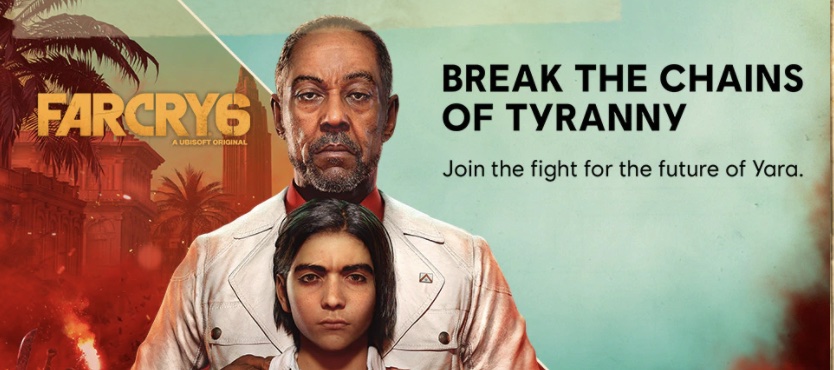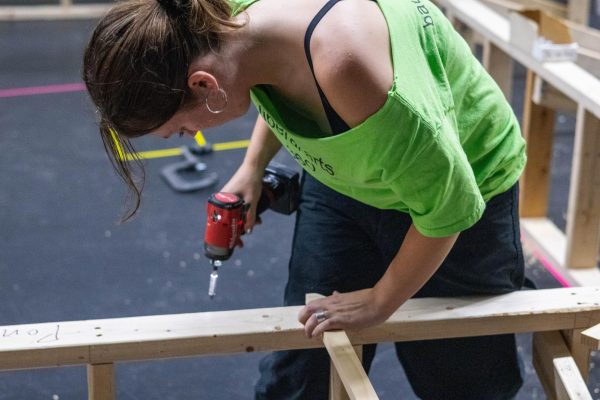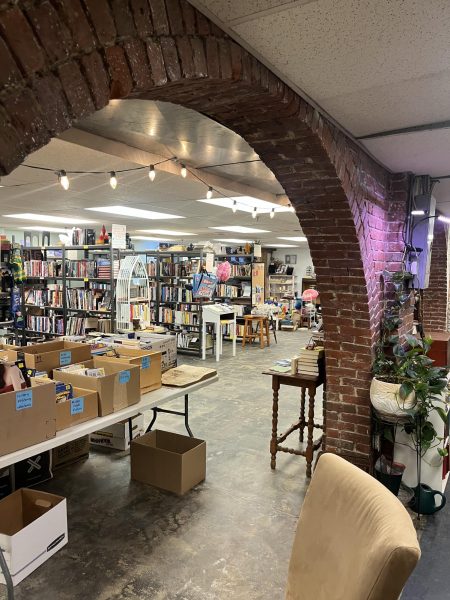Sometimes, the Same Is a Good Thing: A Far Cry 6 Review
The newest edition of the Far Cry franchise involves working to free Yara from the clutches of authoritarian dictator Anton Castillo, voiced by Giancarlo Esposito (back).
In the era of COVID-19, I feel like life switches up on me every six seconds or so. It’s exhausting. One minute I’m lying on the beach in flip flops and no mask, next thing I know I’m being tested twice a week and threatened with being locked in a hotel for two weeks. It totally sucks. In tumultuous times like these, what I take the most solace in are the things that haven’t changed — things that don’t really want to be brand spanking new, just really good.
In recent years, as nerds of my caliber will be familiar with, the Ubisoft series Assassin’s Creed went through a massive overhaul of their engine and playstyle that resulted in a deeply different but deeply better player experience. It was a much-needed overhaul for a series that I’ve loved for well over a decade — yes I played Assassin’s Creed when I was 10; no, my mom didn’t really know what it was — that improved and revitalized a franchise that had grown stale to the palate of its devoted fanbase.
You know what didn’t need a rehaul, though? Far Cry. Far Cry, if you don’t know, is Ubisoft’s other politically charged action series full of fighting power with a bit of elbow grease and deeply unrealistic health regeneration. Far Cry 3, the first installment of the series on Xbox 360 and PS3, is widely considered to be one of the best games ever made.
The storyline goes like this: You are in an isolated area, with no hope of outside help, under the brutal hand of some sort of psychotic dictator. You need to build up your own power while totally obliterating the dictator’s power to reclaim the land for the people it belongs to, and out of the hands of its oppressive monarch.
Its most recent installment, Far Cry 6, is more of the same in a good way. Anton Castillo, played by the incomparable Giancarlo Esposito (Gustavo from “Breaking Bad”), is as terrifying a villain as it gets, ruling the country of Yara with an iron fist and a whole lot of poison. In an era where right wing authoritarianism is very much on the rise, we see the full harmful potential of this troubling wave right in Esposito’s face.
You play as Dani Rojas, who can be gendered as you please, a discharged Yaran army vet. When Anton declares martial law, they flee the city and wind up on the shore of Libertad, the guerilla revolutionary group with aspirations of restoring democracy to Yara.
Your goal is to gain allies, capture bases, shoot a bunch of enemies in the head, drive a bunch of awesome vehicles and lead the revolution to the steps of Anton’s palace.
A consistent theme in the Far Cry franchise has been the hero “becoming the villain,” essentially saying that once you start killing people with the wanton that your character does, you become no better than the villain themselves.
We see a bit of a different message in Far Cry 6, with the idea of revolution being more center stage than the violent tendencies of Dani themselves. Are you truly freeing Yara, or are you forcing it into another cycle that inevitably ends in another brutal dictatorship holding it hostage? You probably know the answer.
This is going to be a pretty in-depth review, so I’m going to be categorizing it as I go. If you see a category you don’t care about, feel free to skip over it. If you see something you care about, please read along. It’s long, is the point. Like, way too long. But there’s a lot to cover here.
Representation
Per usual with the Far Cry series, we get the main story of bringing down the dictator coupled with a subplot divided into regions that you conquer as the game progresses. What I will say is that while Far Cry has always been a “woke” franchise as video games go, they’re far more in your face about it this time, in a good way. While things like racism, classism and homophobia are implied in previous games but never directly addressed, this time they are brought up. And they do it with the nuance and respect that is demanded of such sensitive issues.
Anton is a wild transphobe. One of your allies, Paolo, is a discharged soldier who was kicked out of the military for being trans. He is treated exceptionally poorly by the soldiers of the FND, Yara’s army, and misgendered intentionally by the antagonist of that particular subplot.
It’s a brutality, which, at least to me, feels necessary, because that is in fact what happens when hate is allowed to spread. I think it paints the character as deeply resilient and easy to identify with. He had top surgery without antiseptic, he leads a revolution, he’s smart and he’s calculated. He’s an absolute badass.
Paolo endures trauma as a result of his status as a trans man, but is never defined by it in the story. His calling cards are his bravery and his strong sense of self. It’s deeply refreshing to see a trans character that is defined by something other than his gender identity. If you’re trans and you disagree with me, feel free to contact me, I’m always more than happy to listen and learn, but to me, this is a great step toward trans representation in video games.
In terms of racism, discrimination actually comes more from Anton and his points more than any other. When an American reporter questions Anton’s methods of producing Viviro, the cancer-curing drug developed by his country, he points out that America profited from slave labor and was built on the backs of people who look like him. And that now we have created a legal form of slavery through a prison industrial complex that creates almost 30% of our domestic product while paying them literal pennies for their labor. And, he’s totally right.
Now, this, of course, is quite a lofty stance for someone who’s created his own form of slavery in the form of “Outcasts” who you free throughout the game, but Anton’s never called on it by any non-Black characters. Rather, it is your Afro-Yaran allies that call Anton out and put his people’s treatment into question. The clear step away from saviorism was, again, very refreshing.
I think overall, Far Cry 6 does an excellent job of addressing social issues by taking them head-on and giving them a voice. There’s also an organic feeling when it comes to representation here. Often, especially in this era, corporations and production companies will cram as many marginalized groups as they can into a single space to get that pat on the back from liberal America without actually putting in the work.
But here, I would say work was done. This is a diverse story of diverse people with diverse experiences, and everyone is given a voice. I would say kids should play this game if it weren’t for the truly inconceivable amount of brutal death involved.
Rating: 5 out of 5, but I’m also a cis white guy.
Graphics/Game Design
Beautiful. I’m not going to act like I know every little detail about the world of graphics, but I do know that Yara looks amazing, the detail is incredible and for the game’s massive size, it has relatively few bugs. Sure, you’re going to have to reload your last save a few times because an objective won’t load, but with a game this size that’s to be expected. There’s no massive game glitches or anything that stops you from playing or immersing yourself in the world, and that’s what’s more important to me.
There’s also far more realism to this game than past installments or really other games I’ve played before. Like, if you stand on top of a chain link fence, you will fall over. If you shoot at a wall that wall will explode, or at least show damage. Little details like that are what truly show how far games have come. It immerses you further in.
Rating: 4 out of 5, because some bugs are there.
Gameplay
The Far Cry series has long been known to have a very consistent style of gameplay, with side quests and even minigames having a largely consistent thread from game to game. What I appreciated about their approach this time was they kept it familiar while still introducing new aspects that took center stage versus some of their more traditional game modes.
Legendary animal hunts, for example, have been a massive part of previous games, even being necessary for maxed out equipment in the past. Now, they’re not even registered as quests, but do remain available.
The concept of the guerilla camps, which can be customized and upgraded, is new, albeit mildly underwhelming. I feel like the workload required is minimal to fully upgrade a camp, especially if the game is done thoroughly, and the rewards for upgrading a camp are somewhat minimal as well.
A great success, at least to me, was the introduction of the special ops mission. Hop in Lola’s taxi and steal some chemical weapons. They’re really quite fun and an interesting changeup to the game’s pace. I just wish there were more.
The actual fighting has been massively upgraded. The engine remains that of the standard first person shooter — which, why wouldn’t it — but your arsenal has become far more customizable. You can choose your gun’s color, sight, what type of bullets you use, the rate of fire, the suppressors — anything you could want to improve or edit on a firearm, you can. Got an armored enemy? Armor piercing rounds. Little less padded? Soft target rounds. Want to blow them up? Explosive rounds.
Scavenging is also key. For camps, weapon upgrades, car upgrades, whatever, you need metal, medicine and gas. It’s way more realistic, and also has actual currency take a backseat, which makes things more engaging.
Rating: 5 out of 5 for making things more interesting.
Story
Holy crap, the story. Is so good. As usual, it has a little secret ending that adds to the further part of the story that makes you go “whoa.” I won’t talk about the story too much, because I don’t want to spoil anything, but it is so, so, so good. Esposito’s performance is gravitating; the story is sad but inspiring, yet also grounded in realism.
Basically, here’s a rundown of the beginning: Dani is with their two friends, Lita and another guy who dies immediately, when Anton declares martial law in the city of Esperanza. Your friend is shot in the head immediately for saying “FUCK CASTILLO,” which, while brave, didn’t seem too smart given the circumstances. You and Lita run to the boat that’s waiting to take you out of Yara; once on the boat, it’s boarded by Anton himself, who is trying to stop his son, Diego, from fleeing Yara.
After taking Diego home, Anton orders everyone on the ship to be killed, when Dani and Lita miracuously escape and wash up on an island. But Lita has been shot, and with her dying breath tells Dani to join Clara Garcia, the leader of Libertad, the guerilla fighters pushing back against Anton. She also calls Dani, “the lucky one.”
Now, that’s all I can really tell you without ruining everything, but the character arcs are incredible, the villain is more human than in the past yet scarier than ever and Diego is a unique addition that adds incredible story value. It’s perfect. Except the Maximas Matanzas arc could use some work. It felt a bit disjointed and ended in a weird way, but it wasn’t bad.
Rating: 4 and a half out of 5, just because I’m comparing it to Far Cry 3.
So, overall? I loved this game. It wasn’t too different, but I didn’t want it to be. I loved it.
Overall: I’m bad at math, but let’s say Far Cry 6 got a 4.8 out of 5.
Your donation will support the student journalists of Bates College and help us cover our annual website hosting costs.








Martin Goodnews • Nov 3, 2023 at 7:46 AM
This blog contains some fairly unique and helpful information. I would be happy to read more of your blogs, so keep up the good work.
Far Cry 6 to stop receiving future updates but online services on the other hand will continue. With the recent development, the developer behind the game, Ubisoft has thanked players for their continued support.
There are additional details on my blog. To find out more, visit the website. Don’t let this chance slip away.